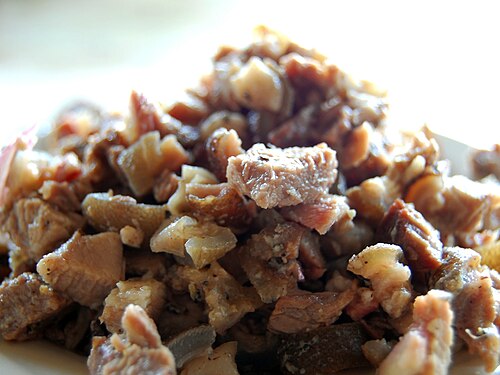Kilawin
Kilawin is a traditional Filipino dish, often considered a delicacy, that primarily consists of raw seafood or sometimes meat, marinated and cooked in vinegar, citrus juice, and a mixture of spices. This dish is closely related to ceviche, a popular Latin American dish, but has distinct characteristics and preparation methods that reflect the unique culinary traditions of the Philippines. Kilawin is not only a testament to the rich biodiversity of the Philippine archipelago, which provides a wide array of seafood and other ingredients, but also showcases the ingenuity of Filipino culinary practices.
Ingredients and Preparation
The primary ingredient of Kilawin can vary widely, including but not limited to, fish (tuna, mackerel, or milkfish), seafood (shrimp, squid, or octopus), and even meat (usually goat, pork, or beef). The choice of main ingredient often depends on regional availability and personal preferences. The meat or seafood is thinly sliced or chopped and then marinated in a mixture of vinegar or citrus juice, such as calamansi or lemon juice, which effectively "cooks" the protein through acidification.
Additional ingredients include onions, ginger, chili peppers, and sometimes a pinch of salt and pepper to taste. Some variations may also include coconut milk, adding a creamy texture and rich flavor to the dish. The inclusion of these ingredients not only enhances the flavor but also contributes to the dish's overall appeal.
Cultural Significance
Kilawin is more than just a dish; it is a cultural symbol that represents the Filipino people's connection to their maritime environment and their resourcefulness in utilizing available resources. It is commonly served during special occasions, gatherings, and fiestas, highlighting its importance in Filipino social and cultural life.
Regional Variations
The Philippines is an archipelago with over 7,000 islands, and as such, Kilawin has various regional variations that reflect the diverse culinary traditions across the country. For instance, in some regions, Kilawin is prepared with a heavier emphasis on vinegar, while in others, the use of citrus juice is more pronounced. Additionally, the type of protein used can vary significantly from one region to another, depending on local preferences and availability.
Health Considerations
While Kilawin is a beloved dish, it is important to note that consuming raw or undercooked meats and seafood can pose health risks, including the potential for foodborne illnesses. It is crucial to use fresh, high-quality ingredients and maintain proper hygiene during preparation to minimize these risks.
Conclusion
Kilawin stands as a testament to the richness of Filipino culinary tradition, offering a unique blend of flavors that reflect the country's diverse culture and history. Whether enjoyed as a main dish or an appetizer, Kilawin remains a cherished part of Filipino cuisine, celebrated for its taste, simplicity, and cultural significance.
Transform your life with W8MD's budget GLP-1 injections from $125.
W8MD offers a medical weight loss program to lose weight in Philadelphia. Our physician-supervised medical weight loss provides:
- Most insurances accepted or discounted self-pay rates. We will obtain insurance prior authorizations if needed.
- Generic GLP1 weight loss injections from $125 for the starting dose.
- Also offer prescription weight loss medications including Phentermine, Qsymia, Diethylpropion, Contrave etc.
NYC weight loss doctor appointments
Start your NYC weight loss journey today at our NYC medical weight loss and Philadelphia medical weight loss clinics.
- Call 718-946-5500 to lose weight in NYC or for medical weight loss in Philadelphia 215-676-2334.
- Tags:NYC medical weight loss, Philadelphia lose weight Zepbound NYC, Budget GLP1 weight loss injections, Wegovy Philadelphia, Wegovy NYC, Philadelphia medical weight loss, Brookly weight loss and Wegovy NYC
|
WikiMD's Wellness Encyclopedia |
| Let Food Be Thy Medicine Medicine Thy Food - Hippocrates |
Medical Disclaimer: WikiMD is not a substitute for professional medical advice. The information on WikiMD is provided as an information resource only, may be incorrect, outdated or misleading, and is not to be used or relied on for any diagnostic or treatment purposes. Please consult your health care provider before making any healthcare decisions or for guidance about a specific medical condition. WikiMD expressly disclaims responsibility, and shall have no liability, for any damages, loss, injury, or liability whatsoever suffered as a result of your reliance on the information contained in this site. By visiting this site you agree to the foregoing terms and conditions, which may from time to time be changed or supplemented by WikiMD. If you do not agree to the foregoing terms and conditions, you should not enter or use this site. See full disclaimer.
Credits:Most images are courtesy of Wikimedia commons, and templates, categories Wikipedia, licensed under CC BY SA or similar.
Contributors: Prab R. Tumpati, MD

